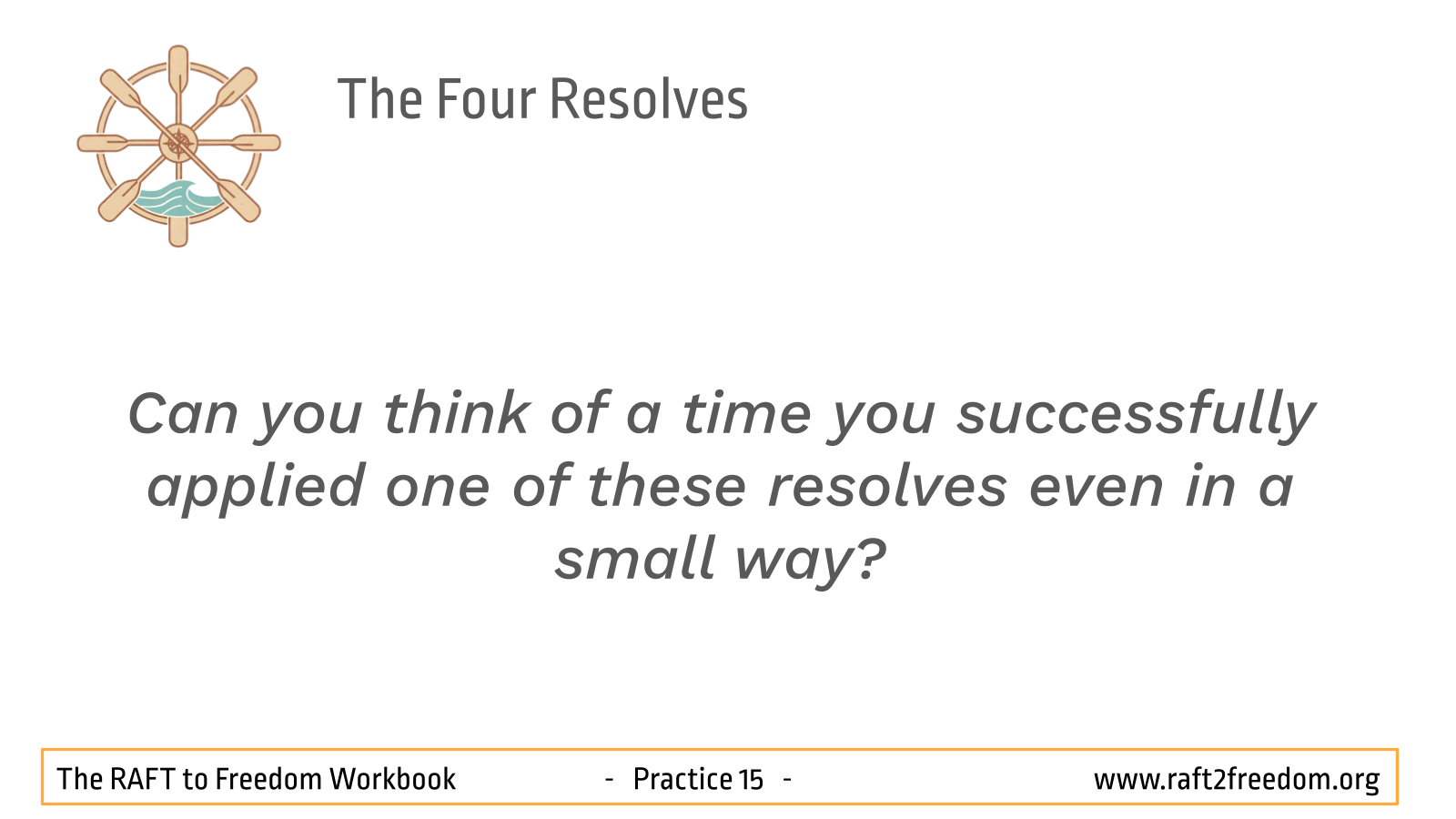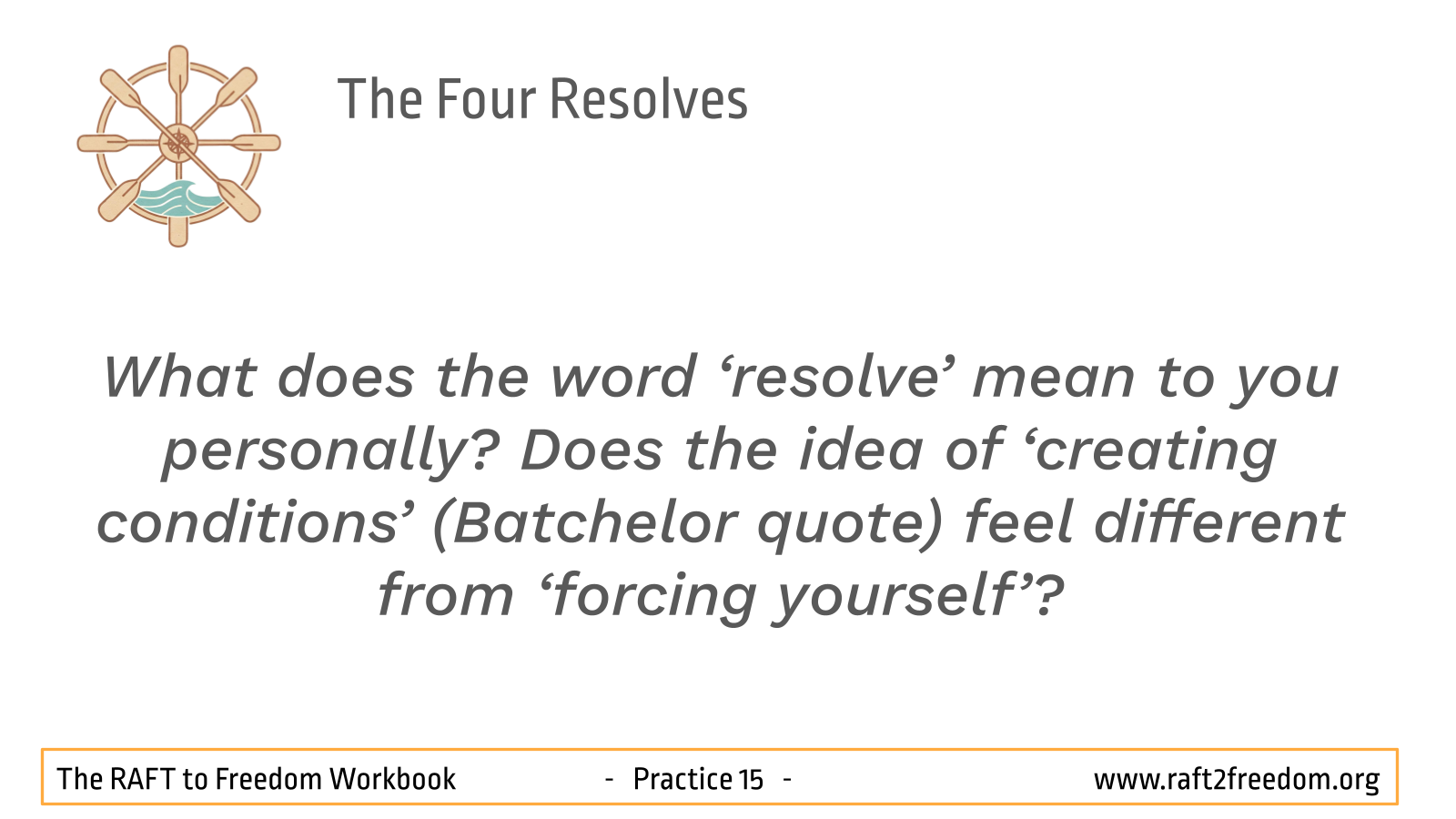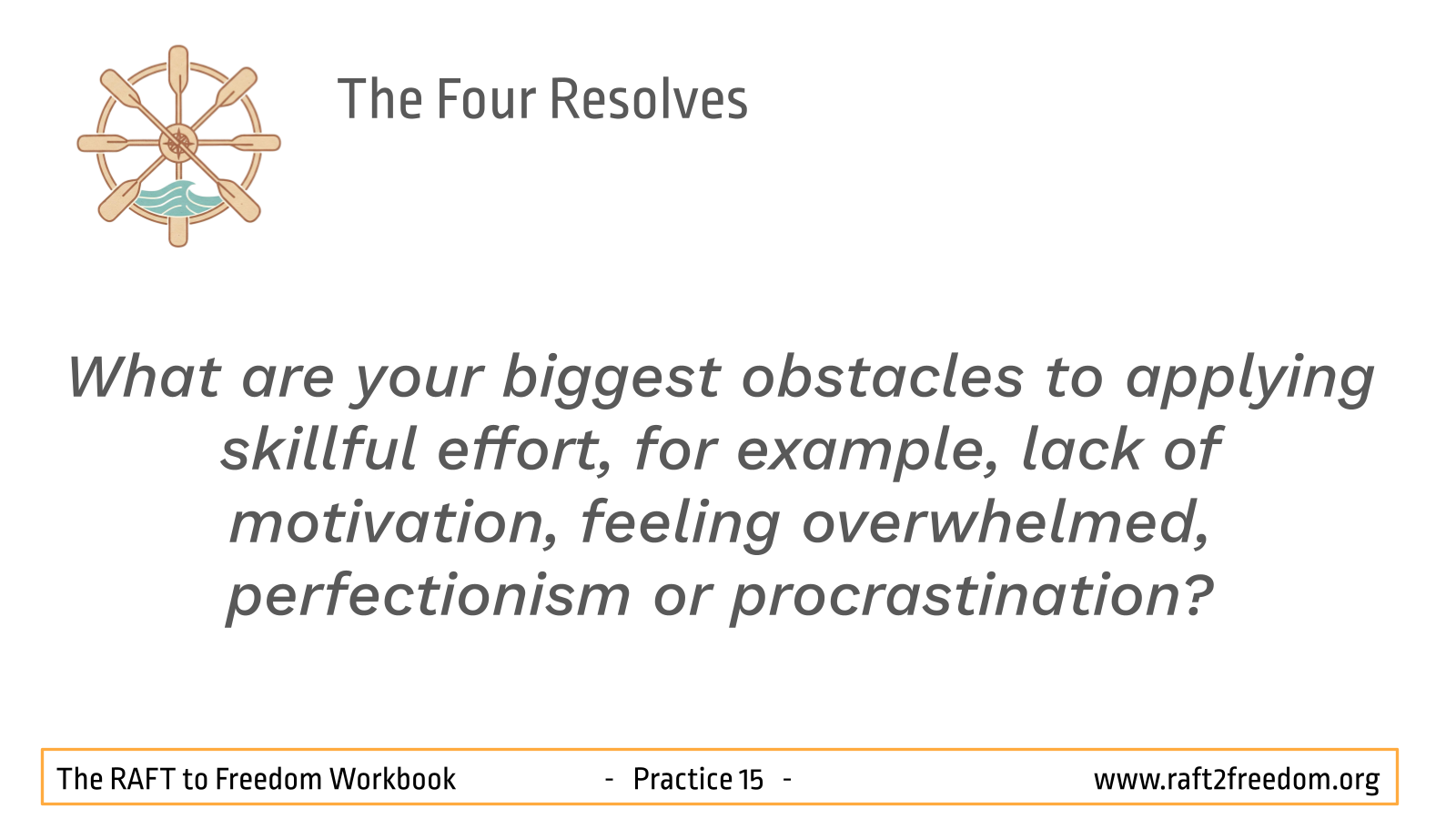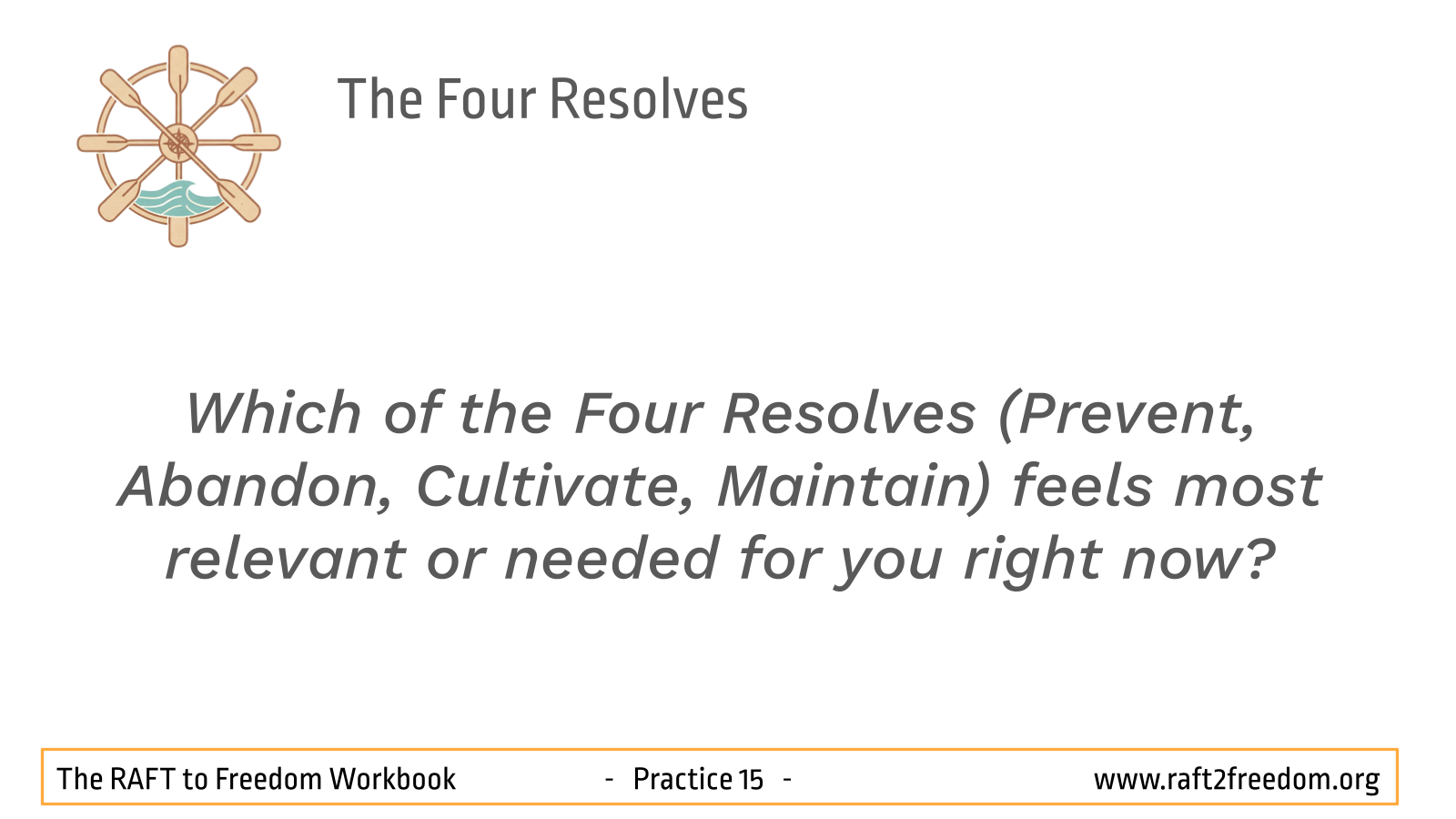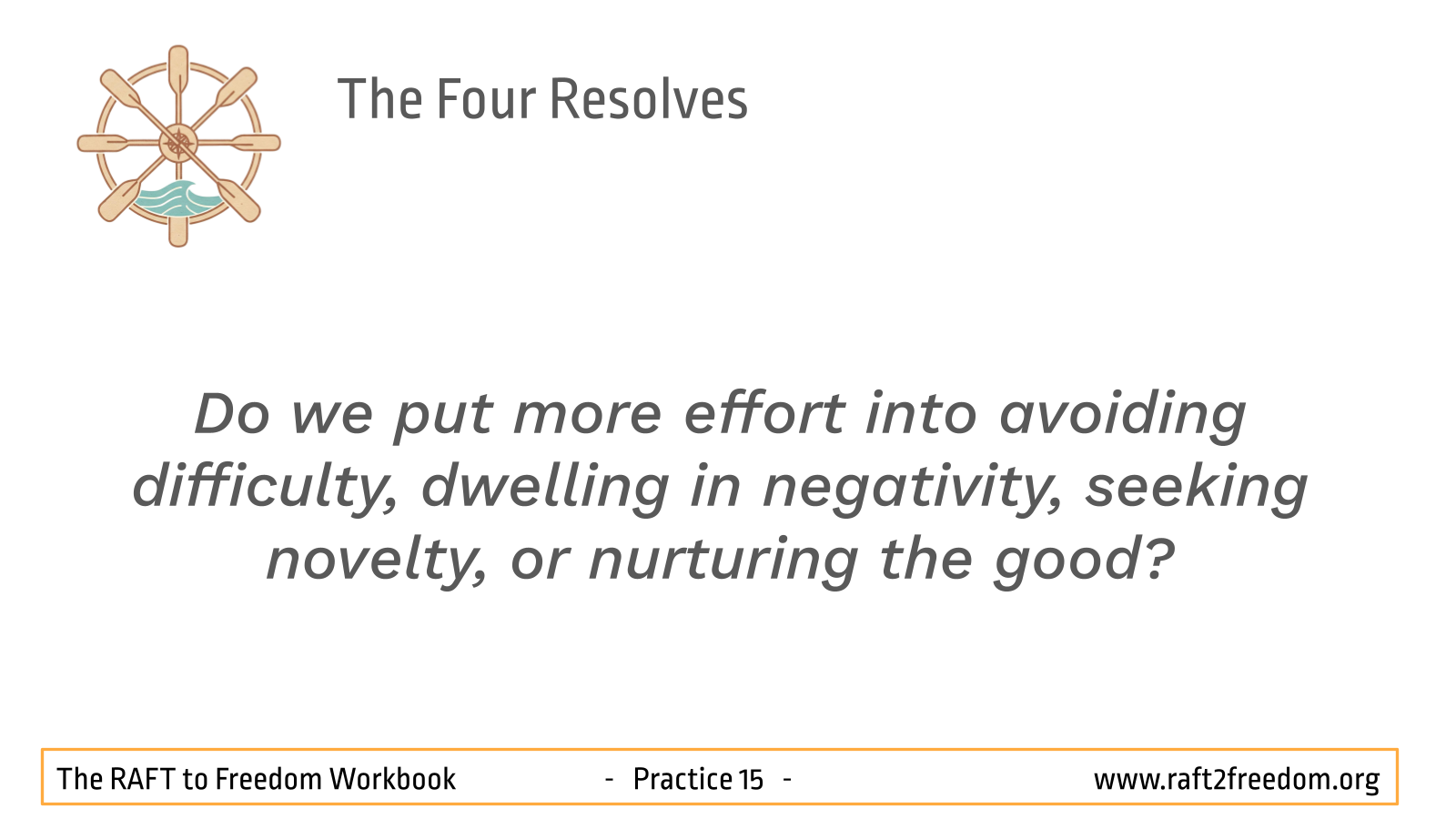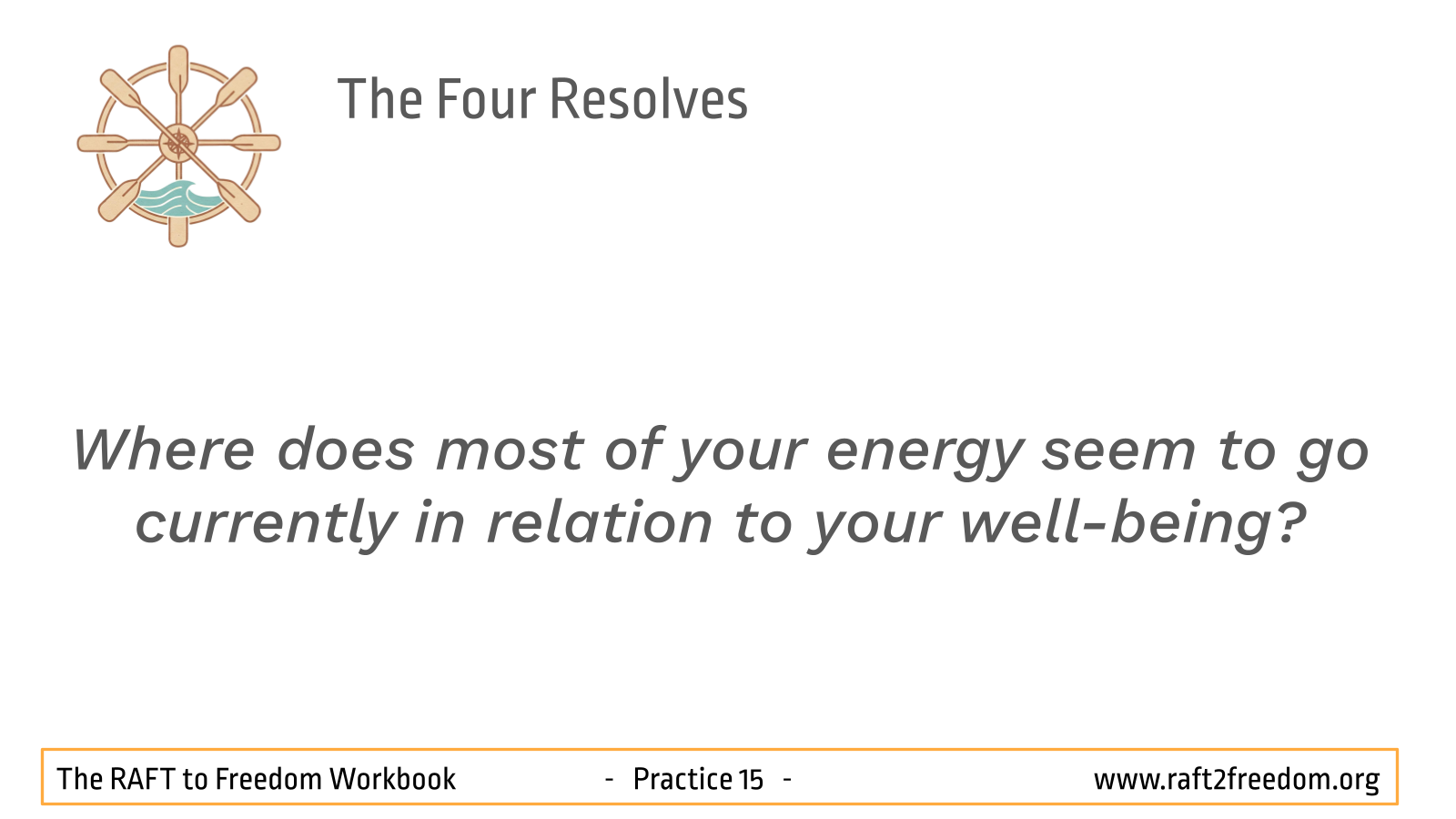Practice 15 – Cultivating the resolve to build and navigate
Directing our energy wisely
“The chains of habit are too light to be felt until they’re too heavy to be broken.”
Samuel Johnson
“We are conditioned, and we can be reconditioned – even unconditioned.”
Vince Cullen

Episode 15 – The four resolves
An AI generated ‘deep dive’ into this aspect of the RAFT to Freedom
Having explored various aspects of mindfulness of the body – from breath and posture to the body’s composition and ultimate impermanence – we continue our exploration of what it is to be human, by turning our attention to how we direct our efforts on our journey to freedom. Recognising the difficulties inherent in life (Gotama, the Buddha’s first reality), and the nature of our embodied experience naturally gives rise to the question: “What do I do with the understanding that life is painful, difficult and disappointing?“
The answer lies in cultivating skillful effort.
This chapter provides an overview of a crucial Buddhist practice known as the ‘Four Great Efforts’, also called the ‘Four Right Strivings’. These four resolves are vital for cultivating helpful mental states and abandoning unhelpful ones.
They are typically defined as:
- Guarding against the arising of unarisen unwholesome states
- Abandoning arisen unwholesome states
- Arousing unarisen wholesome states
- Maintaining and perfecting arisen wholesome states
We will frame these as the Four Resolves, guiding principles that help us channel our energy wisely and compassionately away from harmful patterns and towards healing and freedom. While ‘Right Effort’ is formally the sixth factor of the ‘Noble Eightfold Path’ which we will explore in detail in the last stage of our journey, introducing these intentions early helps us to recognise our current patterns of effort and to understand the kind of resolve we need for our journey ahead.
The Four Resolves are:
- Resolving to prevent harmful cravings and compulsions. To recognise our triggers and to steer clear of risky situations, while avoiding the temptation to replace one addiction or unhelpful habit with another.
- Resolving to abandon our harmful addictions and compulsions that are keeping us stuck in painful places. This is like patching up the biggest holes in our raft to prevent us from sinking.
- Resolving to cultivate helpful, healthier and creative ways to live. In many ways, these healthy habits will replace our old unhealthy habits. For example, developing gratitude, new hobbies, healthier lifestyles and attending support groups.
- Resolving to maintain, strengthen and ultimately embody our new healthier habits and lifestyle. For example, engagement with support networks, daily practices and ethical living.
As Stephen Batchelor notes, true resolve isn’t about brute force:
“Resolve is not about forcing or pushing yourself to do something but about creating conditions in your life that naturally lead you to it. It’s about reorganising your inner and outer life so that your mind and circumstances support what you truly wish to achieve.”
The Four Resolves provide a map for creating these supportive conditions.
These intentions are not rigid rules but compassionate commitments, guiding us to notice where our energy is going and to consciously redirect it towards our healing. Applying our RAFT to Freedom metaphor, these four resolves guide the effort we need to build and navigate our vessel:
- Prevent: We make efforts to avoid known hazards that could damage our raft by steering clear of triggers and guarding our senses.
- Abandon: We actively work to patch the existing holes in our raft – the harmful habits and compulsions keeping us stuck.
- Cultivate: We gather the new, sturdy materials and skills needed for our journey, developing mindfulness, compassion and healthy coping mechanisms.
- Maintain: We diligently maintain our raft, strengthen its structure, and keep steering it skillfully towards the safe shore, by sustaining our daily practice, nurturing our support networks and reinforcing positive changes.
These intentions help us gather the essential tools – that are the ‘four resolves’, and apply them effectively.
A brief look at each resolve:
- The resolve to prevent: To apply effort to prevent the arising of unhelpful states, like harmful cravings, negative thought patterns and relapse justifications, that haven’t arisen yet.
- Practical application in everyday life: This involves identifying personal triggers (people, places, feelings and times of day) and proactively creating strategies to avoid or manage them. It includes setting up routines that support our intentions and learning stress management techniques before overwhelm occurs.
- The resolve to abandon: To apply effort to abandon unhelpful states that have already arisen. Any aspiration for a life free from our harmful cravings and aversions, must start by abandoning our primary unhealthy and unhelpful habits and behaviours. This has to be our initial effort – to be free from the debilitating pull of our harmful compulsive and reactive behaviours – allowing us to cultivate the other three resolves.
- Practical application in everyday life: In order to support our resolve to abandon our most destructive habits, the following tools are available to us. When cravings, difficult emotions, or addictive thoughts do arise, this intention guides us to meet them skillfully – perhaps using mindfulness to observe them without acting (like surfing a wave) and, applying cognitive techniques to reframe thoughts, or perhaps engaging in healthy distraction activities when our urges arise. As Jon Kabat-Zinn famously said, “You can’t stop the waves, but you can learn to surf.”
- The resolve to cultivate: To apply effort to cultivate helpful states like mindfulness, kindness, calm, and other new healthy habits.
- Practical application in everyday life: This is about actively building the positive. It means exploring new, healthy sources of pleasure and meaning, for example, new hobbies, new connections, and helping others. We adopt the practice of gratitude, to shift our focus from what’s lacking to what’s present, and engage in acts of kindness to foster a sense of purpose. As Pema Chödrön suggests, “We can begin to drop the storylines that perpetuate habitual patterns of self-denigration, and instead start to cultivate loving-kindness.”
- The resolve to maintain: To apply effort to maintain and develop helpful states that are already present.
- Practical application in everyday life: Freedom isn’t just about stopping the negative; it’s about nurturing the positive. This resolve involves us building routines that reinforce our good intentions, for example, meditation, exercise and attending support groups. We reflect on our progress; practising self-compassion during setbacks; and strengthening our support networks. This might include keeping a reflective journal to track and contemplate on positive changes, and regularly acknowledging and celebrating our progress to reinforce these helpful states.
These intentions help us recognise our tendencies – do we put more effort into avoiding difficulty, dwelling in negativity, seeking novelty, or nurturing the good?
The power of profound commitment: an alternative approach.
The Four Resolves are not merely actions but profound commitments. Best exemplified in the Thai Monastery Wat Thamkrabok, deeply rooted in the principle and practice of ‘Sajja’ (pronounced ‘Sat-cha’). Sajja, in this instance encompasses truth, truthfulness, and a personal vow, signifying a deep-seated promise to oneself to abandon harmful behaviours and to cultivate and embrace a new life. This solid commitment to change underscores the importance of the resolve needed for our journey to freedom. The monks at Wat Thamkrabok Monastery famously attribute 95% of recovery to Sajja, emphasising that it is a fundamental internal transformation beyond a superficial declaration. Embracing these intentions means acknowledging the truth of our past actions and committing to a path of healing and liberation.
The ‘Rahula Rules’: A guide for skillful action
Gotama’s advice to his young son Rahula provides a practical framework for applying the four resolves in daily life, especially regarding ethical action and mindful decision-making. What we might call the ‘Rahula Rules’ encourage a moment-to-moment awareness that supports us in preventing unhelpful actions and cultivating helpful new ones:
- Rahula rule 1 – Reflect before you think, speak, or act
- Consider: “Will this mental, verbal, or bodily action cause harm to me or others?” If ‘yes’, then perhaps you should not do it. If ‘no’, then carry on. This rule directly supports the resolve to Prevent unhelpful states from arising by promoting conscious, pre-emptive awareness.
- Rahula rule 2 – Assess while you are thinking, speaking, or acting
- Consider: “Is this mental, verbal, or bodily action causing harm to me or others?” If ‘yes’ then perhaps you should stop doing it right now. If ‘no’, then carry on. This rule is crucial for the resolve to Abandon unhelpful states that have already arisen, allowing for real-time course correction.
- Rahula rule 3 – Review that thought, speech, or action
- Consider: “Did that mental, verbal, or bodily action cause harm to me or others?” If ‘yes’, then perhaps you should resolve ‘not to do it again’. If ‘no’, then this was a wise, helpful action. This rule supports both the resolve to Cultivate by reinforcing positive learning, and the resolve to Maintain helpful qualities, ensuring continuous improvement and ethical living.
In short, these rules remind us to be mindful about anything we do, and if the intention or result is to cause harm to you or anyone else, then it is not a helpful or wise choice… ‘It will not make anything better!’
Modern therapeutic applications
The four resolves are brought to life through specific practices and tools, many of which align with modern addiction treatment protocols:
- Mindfulness-Based Cognitive Therapy (MBCT): Combines mindfulness and cognitive-behavioural strategies to help individuals observe cravings and negative thoughts without acting on them, supporting the ‘intention to abandon’.
- Acceptance and Commitment Therapy (ACT): Encourages acceptance of cravings and value-driven action, fostering commitment to a life free from destructive cravings and habits, aligning with all four intentions.
- Motivational Interviewing (MI): Helps individuals explore and resolve ambivalence about change, aligning with the effort to cultivate wholesome intentions and resolve.
- Mindfulness Based Relapse Prevention (MBRP): Combines mindfulness practices with cognitive and behavioural relapse prevention strategies to help individuals recovering from substance use disorders.
- Mindfulness Based Addiction Recovery (MBAR): Incorporates formal mindfulness practices like meditation and body scanning, and informal practices like mindful movement. These practices cultivate awareness of triggers, internal reactions, and promote skilful responses.
Self-Reflections
Consider your own patterns of effort, intentions and resolves:
- Where does most of your energy seem to go currently in relation to your well-being or recovery?
- Do we put more effort into avoiding difficulty, dwelling in negativity, seeking novelty, or nurturing the good?
- Which of the Four Resolves (Prevent, Abandon, Cultivate, Maintain) feels most relevant or needed for you right now?
- What are your biggest obstacles to applying skillful effort, for example, lack of motivation, feeling overwhelmed, perfectionism or procrastination?
- What does the word ‘resolve’ mean to you personally? Does the idea of ‘creating conditions’ (Batchelor quote) feel different from ‘forcing yourself’?
- Can you think of a time you successfully applied one of these resolves even in a small way?
Journaling Prompts
Explore these intentions more deeply through writing:
- Mapping Your Efforts: For each of the ‘Four Resolves’, identify one specific example of how you are already applying it (even slightly) or one specific area where you could apply it more consciously in your practice this week.
- Creating Supportive Conditions: Reflecting on Stephen Batchelor’s quote, what specific conditions in your inner life (for example, attitudes, beliefs) or outer life (for example, environment, schedule, relationships) could you adjust to better support your intentions?
- Effort vs. Striving: Explore the difference between skillful, balanced effort and anxious, stressful striving. Where do you tend to fall on this spectrum? How can self-compassion help balance your effort?
- Small Steps: Choose one of the ‘Four Resolves’ that feels important but challenging. Brainstorm one very small, achievable action step you could take related to that resolve in the next 24 hours. Write it down.
Supporting Material: Scientific and Philosophical Perspectives
For those interested in the scientific and philosophical underpinnings of The Four Resolves, the following overview highlights some key connections. The wisdom of the ‘Four Resolves’ resonates with modern understanding:
- Neuroscience: Skillful effort involves engaging the prefrontal cortex (PFC) for executive functions like planning, impulse control, and goal-directed behaviour, overriding more automatic, habitual responses, often mediated by the basal ganglia (implicated in addiction). Neuroplasticity confirms that repeated, effortful practice of new behaviours (cultivating/maintaining the skillful) literally rewires the brain, strengthening positive pathways and weakening old addictive ones. As Rick Hanson notes, “The brain is like Velcro for negative experiences and Teflon for positive ones. But with mindfulness, you can tilt your mind toward the positive, developing inner strengths that support resilience and happiness.”
- Psychology: Goal-Setting Theory emphasizes the importance of clear, specific goals (supported by these resolves). Self-Regulation models describe the effortful process of managing thoughts, feelings, and behaviours. Behavioural Activation shows that making the effort to engage in positive activities can improve mood and motivation. Relapse Prevention planning directly incorporates strategies for preventing triggers, abandoning urges, cultivating coping skills, and maintaining lifestyle changes.
- Philosophy: ‘Virtue Ethics’ (like Aristotle’s) stresses that good character is built through consistent, effortful practice of virtuous actions (cultivating/maintaining). Stoicism emphasizes directing effort towards what is within our control (our responses and intentions) and accepting what is not. Concepts of willpower, discipline, and commitment are central themes in many philosophical discussions on living a good life.
Remember to Remember
The ‘Four Right Efforts’, or Four Resolves, provide a vital, practical framework for channelling our energy wisely on the path away from our destructive cravings and habits and towards freedom. They offer a compassionate yet clear-sighted structure for recognising where effort is needed: preventing the harmful, abandoning what has arisen, cultivating the beneficial, and maintaining the progress made.
Understanding these intentions is a key part of recognising the landscape of our inner world and the tools available for navigating it. While ‘Right Effort’ is a core component of the ‘Eightfold Path’ explored fully in a later chapter, embracing these resolves now provides direction and empowers us to actively participate in our liberation from the outset. They remind us that transformation requires not just passive awareness, but also skillful, courageous, and persistent effort – the energy needed to build, maintain, and propel our raft towards the safe shore.
Sutta References
- Sammappadhana Vibhanga Sutta (SN 45.8 – Analysis of Right Effort, as part of the Eightfold Path): Provides the standard definition within the context of the path.
- Summary: Defines Right Effort (Samma Vayama) precisely through the fourfold formula: “Here, monks, a monk generates desire, endeavors, activates persistence, upholds & exerts his intent for the non-arising of evil, unskillful qualities that have not yet arisen… for the abandoning of evil, unskillful qualities that have arisen… for the arising of skillful qualities that have not yet arisen… for the maintenance, non-confusion, increase, plenitude, development, & culmination of skillful qualities that have arisen.
- Anguttara Nikaya 4.14 (Effort / Striving): This sutta details the Four Right Efforts.
- Summary: This text elaborates on the Four Right Efforts (referred to as padhāna – exertions), explaining each of the four aspects (preventing, abandoning, developing, maintaining) as essential components of diligent practice leading towards liberation. It uses the terms “Restraint, abandoning, development, and protection.”
- Viriya Sutta (Various, for example, SN 48.50): Discusses effort/energy as a faculty and power.
- Summary: Reinforces the importance of Viriya (effort, energy, persistence) as one of the five spiritual faculties and powers, essential for overcoming obstacles and achieving spiritual goals. The Four Right Efforts are the practical application of this quality.
RAFT to Freedom © 2025 by Dr Cathryn Jacob and Vince Cullen is licensed under CC BY-NC-SA 4.0. To view a copy of this license, visit https://creativecommons.org/licenses/by-nc-sa/4.0/ |
